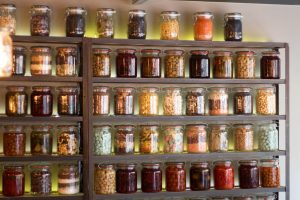I think it’s easy to get so bogged-down with the zealotry of idealism that we are too overwhelmed to just do what needs doing. I’ve found this to be true here on our homestead. We want so badly to be producing our own vegetables, meats, eggs, and dairy but we also need to live in the reality of having four young children, living without electricity or running water, and rebuilding very poor soil. It’s a process, right?
I’ve found that the same principle can be applied to the Traditional Foods movement. You read Sally Fallon-Morell or Joel Salatin or Michael Pollan and you think wow, it would be great to be doing all of these things to feed my family. But then you’ve also got a full-time job or a new baby or a tight budget, or all of these things. And it becomes so overwhelming that you just throw your hands up and go back to what was easy, what was familiar.
Yesterday I was simmering a couple of huge stock pots of beef broth from a cow recently butchered by our neighbors. While that bubbled away I took a few minutes to chop up a ton of cabbage, garlic, and carrots for 1.5 gallons of fermented vegetables. None of this took more than 30 minutes (total) of hands-on time, the bones were free (we just had to ask), and that gallon-and-a-half of kraut that will last us several weeks cost maybe $5.
But eight years ago, when I just started down the path towards traditional foods, I really wish someone had simplified it into doable steps that I could take one at a time. So today, I thought I’d do that, in case you’re where I was.
Learn how to source ingredients. If you learn to do nothing else, spend your time on only one thing, and spend your hard-earned dollars only one way; this is it. Find animals reared properly – grass-fed beef, pastured chickens and eggs, grass-fed dairy. Eat grass-fed butter, lard, tallow, and coconut oil liberally. When you’re ready to move on from this, find local vegetables and fruits. Once you are stocked with nutrient-dense foods everything else sort of falls into place.
Learn to ferment vegetables. Our family can easily eat 1/2 gallon of kraut or other fermented vegetables per week. Even though I spend 30 minutes making it – boiling it down to 10 minutes/week – it saves me loads of time. It becomes our enzyme at meals, allowing me to forgo making that salad just because. It allows me to get all of my chopping done in one go. It allows me to use whatever vegetables are coming from the garden or market. And it’s so. incredibly. simple.
Learn to make bone broth. Good golly, if I had a bumper sticker it would say “eat more bone broth”. This stuff is like liquid gold and frankly when we butcher a rooster I could care less about the meat when there’s that bubbling pot of goodness filled with golden chicken fat drops on our wood stove. Consuming bone broth in soups, stews, rice, beans, or straight up has to be one of the most inexpensive and delicious ways to transform your family’s health. Seriously, put anything in homemade bone broth and it will be lick-the-bowl good. I know, I’m gushing, but I’ve seen what this stuff can do.
Learn to ferment dairy. Once you’re sourcing good milk from a clean dairy, it’s time to add some more probiotics and enzymes through culturing. Milk kefir and yogurt are the obvious places to start but you could culture cream for sour cream and then make your own butter. And once you make these in a large batch, you have super simple meals at your fingertips.
Learn to soak and sour your grains. Boy howdy people really get worked up about grains. Sometimes we’re too attached, other times we project our own issues with grains on everyone else. How about a simple rule: just eat what makes you feel good and think about how those things were prepared before industrialization? So if you eat grains then making them with sourdough makes sense. Not only does it allow you to save some money on yeast, it also gives your flour a good fermentation which increases its B vitamins while breaking down the fiber to make it more digestible. Same thing with porridge or other baked goods. A little time, bacteria, and warmth can make a world of difference if you have digestive issues.
So, those are the basic skills needed to create nourishing meals. You have to start somewhere, so start simple, and I always like to stick with the motto “Do what you can with what you have.”







